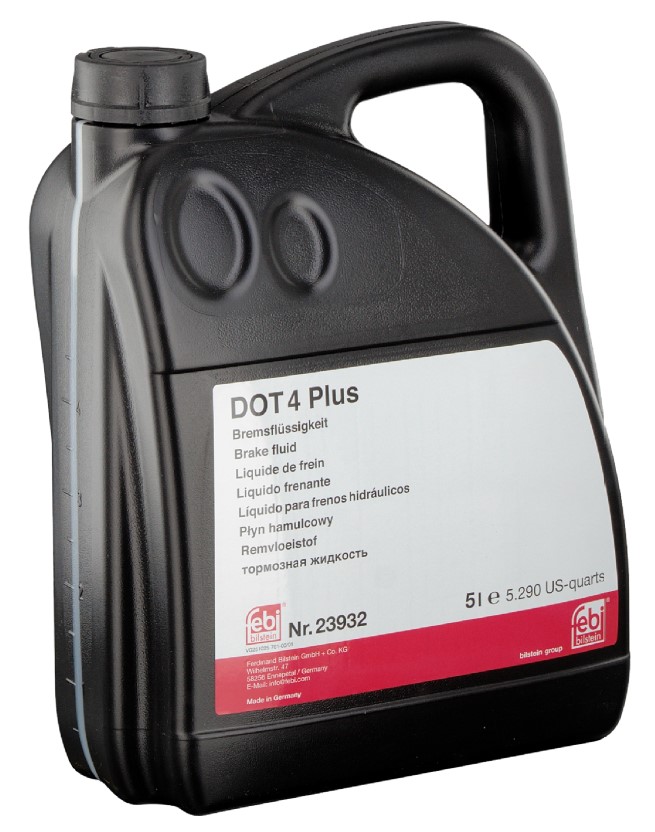Brake fluid is an important component within a vehicle’s braking system. febi DOT 4 Plus is a fully synthetic brake fluid based on glycols. It contains oxidation and corrosion inhibitors, has excellent dry and wet boiling point properties, and also prevents the formation of vapor bubbles.
Friction during the braking process generates heat; some of this is absorbed by the brake fluid which must meet the requirements defined in the applicable standards:
- Dry boiling point of the brake fluid with no water content [°C]
- Wet boiling point of the brake fluid with water content [°C]
- pH value of the brake fluid
The parameters are defined by standards FMVSS No. 116, SAE J1703, ISO 4925, and PN-EN ISO 2719: 2016-08. These constitute some of the basic criteria for determining the suitability for use. The parameters for DOT 4 Plus brake fluids are summarized according to standards SAE J1703 and ISO 4925 (dry and wet boiling points, viscosity), as well as FMVSS No. 116 (pH value). See the table below.
| Dry Boiling Point [°C] | ||
| SAE J1703 | ISO 4925 | DOT 4 Plus |
| 205 | 205 | 260 |
| -285 |
| Wet Boiling Point [°C] | ||
| SAE J1703 | ISO 4925 | DOT 4 Plus |
| 140 | 140 | 180 |
| -200 |
| Maximum Kinematic Viscosity at -40° C [mm2/s] | ||
| SAE J1703 | ISO 4925 | DOT 4 Plus |
| 1800 | 1500 | 1200 |
| -1500 |
| pH Value “Wet” | |
| FMVSS No. 116 | DOT 4 plus |
| 7.0-11.5 | 7.0-8.5 |
Why Does Brake Fluid Have to Be Hygroscopic?
The boiling point of a brake fluid is a temperature where gas bubbles form. As soon as one forms, the pressure in the brake system can no longer be maintained because the gas can be compressed. The consequence is a sudden reduction in braking effectiveness which can lead to an accident.
The hygroscopic property of brake fluid is required so that any water present distributes itself evenly throughout the liquid. If water collects in a specific area, the boiling point will lower to ≈ 100 °C. However, if the water, for example, dissolves at a proportion of 3 %, the boiling point will remain considerably higher than 100 °C where the risk of bubble formation is significantly lower.
Several factors affect and accelerate the absorption of water. These include the storage of brake fluids in open, unsealed packages for long periods of time, non-compliance with brake fluid service intervals, damaged brake system elements, or damaged seals/gaskets.
The hygroscopic properties of the brake fluid stem from the glycol content. This allows the fluid to gradually absorb more and more water which also means that it needs to be changed on a regular basis. Vehicle manufacturers generally recommend changing the brake fluid every 30,000 to 50,000 kilometers or every two years.
Viscosity and Other Properties
The viscosity of a brake fluid defines its intrinsic resistance to free flow at a specific temperature. Under the influence of temperatures in the range of -40 to 100 °C, the viscosity of the brake fluid should be as low as possible.
A low brake fluid viscosity enables rapid pressure changes in the lines of the brake system. This is subject to the driving situation. Alongside the boiling point parameters, the brake fluids must:
- Protect the interior of the brake system from corrosion with corrosion-inhibiting additives.
- Protect the moving components of the brake system at high pressure and low operating speeds as well as at a high operating pressure in the range between of 150 – 180 bars.
- Comply with the permissible swelling and shrinkage of rubber and elastomer seals/gaskets.
- In terms of their bases, they must be mixable and compatible with existing brake fluids and brake systems.




